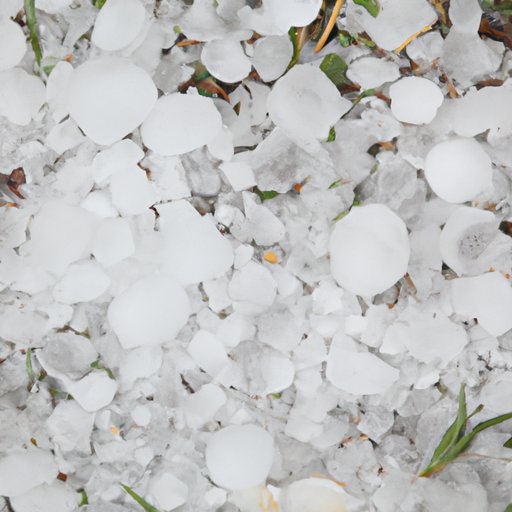Introduction
Hail is a phenomenon that has intrigued and fascinated humans for centuries. While it can be a mesmerizing sight to behold, hail can also be a dangerous and destructive force. Every year, hail causes billions of dollars in damage to crops, homes, and infrastructure, and poses significant risks to human safety. In this article, we aim to provide readers with a better understanding of hail, its formation, impact, and mitigation strategies.
Understanding Hail: Definition, Formation, and Risks
Hail is a type of frozen precipitation that forms in the atmosphere when strong updrafts of moist, warm air carry water droplets high into the sky. Once these droplets reach a certain altitude, where temperatures are below freezing, they begin to freeze and form ice particles. As these ice particles move up and down in the clouds, they accumulate additional layers of water droplets that freeze onto their surface, eventually forming hailstones.
It’s important to differentiate hail from other types of precipitation, such as rain, sleet, and snow. Hail is typically much larger than other forms of frozen precipitation and can range in size from small pebbles to grapefruit-sized chunks. Hailstones can also vary in shape, with some appearing round or irregularly shaped.
While hail can be a beautiful and awe-inspiring sight, it can also pose significant risks to human safety and property. Hailstorms can cause property damage, physical injury, and economic loss, making it essential to understand the science behind hail formation and the dangers it poses.
The Science Behind Hail: How it Forms and Why it Can Be Dangerous
As mentioned earlier, hail formation occurs when strong updrafts of moist, warm air collide with colder temperatures and high altitudes in the atmosphere. As the supercooled water droplets freeze onto hailstones, they accumulate additional water droplets, leading to the accumulation of several layers of ice that can become incredibly heavy and dense.
During this process, hailstones can become so large that they are no longer supported by the updrafts that created them and begin to fall to the ground. The larger and more dense the hailstones become, the faster they fall, posing a significant risk to anything or anyone in their path.
Additionally, hailstones can travel at high speeds, propelled by strong winds, making them more dangerous than other types of precipitation. These factors, along with the potential for lightning, high winds, and heavy rain associated with hailstorms, make them incredibly dangerous and difficult to predict.
Hailstorms: Causes, Impacts, and Mitigation Strategies
While hail can occur in many different weather patterns, the majority of hailstorms happen when warm, moist air rises and meets with cool air, causing significant updrafts in the atmosphere. As these updrafts continue to grow, hail can form and fall to the ground, often accompanied by thunderstorms and high winds.
The impacts of hailstorms can be significant, both in terms of economic loss and physical damage. Hail can cause significant damage to crops, homes, and infrastructure, leading to costly repairs and lost revenue. Additionally, hail can pose risks to human safety, causing injury or even loss of life in extreme cases.
Various mitigation strategies can be used to prepare for and minimize damage from hailstorms. Forecasting technology can help predict and track hailstorms, providing communities and industries with advanced warning to take preventive measures. Insurance policies can provide financial protection in the event of hail damage, while building codes can ensure that homes and public structures are built to withstand extreme weather conditions.
Damage Control: How to Protect Your Property from Hail Damage
While it’s not possible to prevent hailstorms, there are several practical steps you can take to protect your home and car from hail damage. For example, using reinforced roofing materials can help keep your home safe from hail damage, while covering your car with a blanket or car cover can help prevent dents and scratches.
If your property does sustain damage from a hailstorm, filing an insurance claim can help alleviate some of the financial burden of repairs. It’s important to take photos of any damage and document the incident thoroughly to ensure that you receive the maximum amount of compensation.
The Economic Impact of Hailstorms: Analysis and Solutions
Hailstorms can have a profound impact on various sectors of the economy, including agriculture, tourism, and infrastructure. Crop damage from hail can cause significant losses for farmers, while hail damage to buildings and roadways can lead to expensive repairs and safety concerns.
Investing in earlier warning systems, increasing insurance coverage, and investing in research are all potential solutions that can help mitigate the impact of hailstorms. By developing new technologies and systems to predict and prepare for hailstorms, communities and industries can help minimize their exposure to risk and protect themselves from significant losses.
Surviving a Hailstorm: Safety Precautions and Essential Tips
During a hailstorm, it’s important to take safety precautions and avoid danger as much as possible. Seek shelter in a sturdy building or vehicle as soon as possible and avoid open areas, windows, and skylights. If you’re caught outside during a hailstorm, seek cover in a low-lying area and protect your head and face from falling hailstones.
Having an emergency survival kit on hand can also be valuable in the event of a hailstorm or any other emergency. Items such as non-perishable food, water, and first aid supplies can help keep you safe and prepared for any situation.
Conclusion
In conclusion, hail is a fascinating and beautiful phenomenon that can also be incredibly dangerous and costly. By understanding the science behind hail formation, its risks, and mitigation strategies, we can better protect ourselves, our property, and our communities from the impacts of hailstorms. Remember to stay safe during hailstorms and be prepared for any emergency that may arise.
